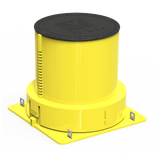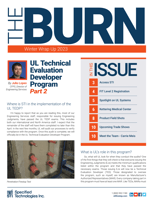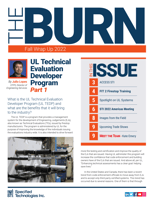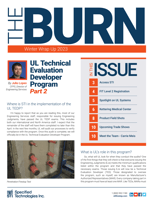In this issue:
STI News
What is the UL Technical Evaluation Developer Program (UL TEDP) and what are the benefits that it will bring to the industry?
The UL TEDP program provides a management system for developing Engineering Judgements (EJs), also known as Technical Evaluations (TEs), issued by firestop manufacturers. The program is administered by UL for the purpose of improving the knowledge of the individuals issuing the evaluations industry wide. It is also intended to drive forward more fire testing and certification and improve the quality of the issued EJs. Having UL administer this program will increase the confidence that code enforcement and building owners have of the issued EJs. And above all, per UL, “Enhancing technical assessments has a clear goal: helping save lives.”
In the United States and Canada, there has been a recent trend from code enforcement officials to move away from EJs and to accept only third-party certified systems. This trend has occurred due to several reasons. One of them is that through a push from the industry for firestop training and through the work of organizations like the International Firestop Council (IFC) and Firestop Contractors International Association (FCIA), the firestop knowledge in our industry has increased, and the importance of the use of firestop products and systems has increased dramatically. This push has highlighted the value of firestop systems and their proper installation.
A second factor in the recent focus solely on third-party certified systems is EJs issued by untrained and unqualified personnel that have reduced the confidence that code enforcement officials have of firestop EJs. So more and more, code enforcement officials would rather play it safe and accept only certified third-party firestop systems. However, EJs still have an important role in construction because not every condition warrants a system, and not every condition can be tested. At times the most appropriate way to handle a field condition, such as minor deviations from a system, is by having the manufacturer issue an EJ. One of the main reasons for this is the time it takes to obtain a certified system.
It could take anywhere from 6 months to a year to obtain a certified system, and waiting this long is generally not an option if the project is already under construction. Other reasons are cost or simply the fact that the condition does not happen often enough to justify the expense of running the testing and then obtaining certification for the system. Once the UL TEDP is fully implemented, code enforcement officials should have more confidence in the EJs that are issued by the manufacturers that take part in the UL TEDP program. That will ultimately help the industry by getting solutions to the construction projects faster and with significantly less expense.
At STI, we are blessed to have the best and most experienced Engineering Services Team in the firestopping industry. But
not all manufacturers have the luxury of having the level of experience, discipline, and proficiency that we have. This program will benefit those that don’t have this level of expertise the most. The TEDP will increase the level of scrutiny for the development of the EJs by requiring those participating in the program to be tested on their knowledge. EJs produced will have to be tracked and audits of their quality management system are mandatory, along with randomly selected periodic fire testing of the EJs that are issued. These key parts of the program will benefit the industry greatly, and the result of all of this is an increase in the number of new UL firestop systems!

Where is STI in the implementation of the UL TEDP?
I’m happy to report that as you read this, most of our Engineering Services staff, responsible for issuing Engineering Judgments, have passed the UL TEDP exams. This includes both our international and North American staff. I expect that the remainder of the staff will have them completed no later than this April. In the next few months, UL will audit our processes to verify compliance with the program. Once this audit is complete, we will officially be in the UL Technical Evaluation Developer Program.
What is UL’s role in this program?
So, what will UL look for when they conduct the audits? One of the first things they will check is that everyone issuing the Engineering Judgments (EJs) meets the minimum qualifications listed within the program and has passed the necessary exams. Those issuing EJs will now be a Technical Evaluation Developer (TED). Those designated to oversee the program, such as myself, are known as Manufacturer’s Authorized Representatives (MAR). Every company taking part in this program must have at least one MAR. Like TEDs, MARs must successfully demonstrate their competency to UL by passing the necessary exams. Along with acting as a resource to the TEDs to assist with resolving questions, MARs are the point of contact for UL and work with UL on compliance and facilitate the UL audits. During the audits, UL will ensure that we are adhering to our policies and management system. Finally, UL will randomly select EJs that have been issued over the year for verification testing. This part of the program will drive further testing and certification.
When will this program be completely in effect?
EJs will be tracked for a full calendar year before UL will first randomly select the EJs. This will happen at one of our future audits. Once this happens, we will have 6 months for penetration and joint systems to run the randomly selected testing. Most if not all these selected penetration and joint tests will be able to be conducted at our state-of-the-art testing facility at our Somerville, NJ headquarters. For duct protection and perimeter-fire-containment systems, UL will allow up to 12 months due to the higher complexity of these systems, the more limited availability of test furnaces or apparatus to conduct the tests, and the higher costs associated with running these tests.
Who benefits from this program?
Participation within the program is limited to manufacturers with UL Certified products tested to US, Canadian, or European standards. Those companies benefit from the credibility of a program administered by a venerable testing and certification agency like UL. But the benefits don’t just apply to these participating companies. The industry benefits from better quality EJs and greater emphasis on education and training for the issuers of the EJs. The program will also shift the focus more onto tested and listed systems, which should significantly increase the availability of such systems. While the inspection community should naturally develop a higher comfort level with EJs produced by UL TEDP program participants, we expect that third-party engineering companies will also benefit from this program’s existence. Whereas EJs are based upon anticipated performance under fire test conditions, a third-party engineer may look at other ancillary systems that provide the requisite level of safety.
Additional information is available on UL’s website, which you can access by following this link: https://www.ul.com/services/technical-evaluation-developer-program.
This article originally appeared as a two-part series in The Burn Fall – 2022 and The Burn – Winter 2023 Wrap up.





